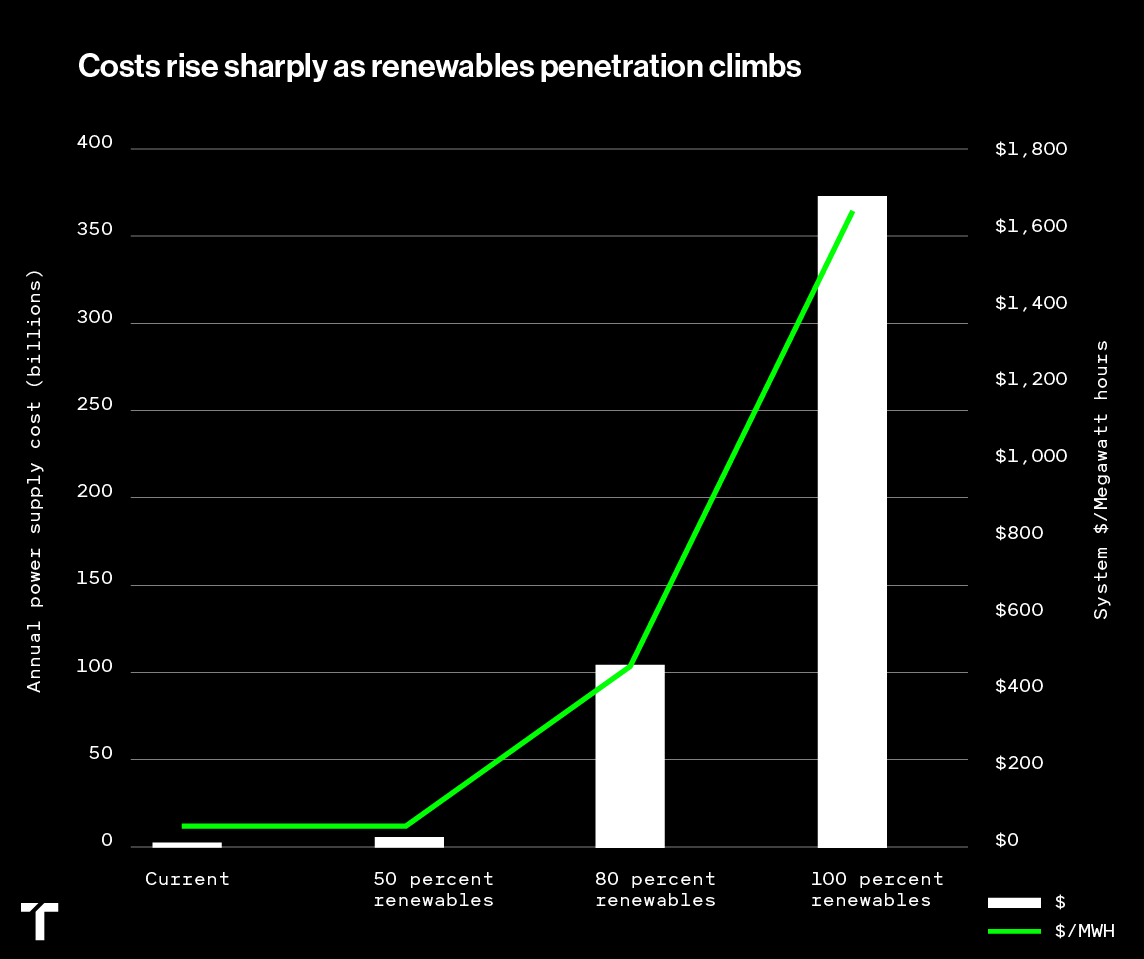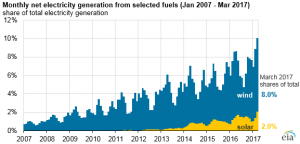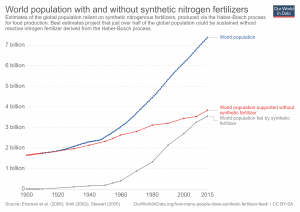“Green New Deal” is now more a slogan galvanizing support for a myriad of state spending programs than a concrete proposal, but two proposals warrant a thorough analysis, House Resolution 109 introduced last week by Rep. Alexandria Ocasio-Cortez (hereinafter the GND) and the the Green Party proposal championed by Jill Stein and others (GPND).
The GPND is more radical and more specific, thus lending itself to a more specific critique, but the House Resolution adopts most of its goals. Both the GPND and the GND replace all electricity generation for the common grid with renewable alternatives emitting no CO2 over a decade, heavily subsidizing investment in the alternatives while (not so) gradually abandoning fossil fuels. The GPND explicitly abandons nuclear power while the GND requires “clean, renewable” sources implying the same effect.
The GPND bans artificial fertilizers and pesticides produced from petroleum and natural gas, innovations enabling a green revolution now feeding much of humanity. The GND is less specific but proposes to “remove pollution and greenhouse gas emissions from the agricultural sector as much as is technologically feasible” and to invest in “sustainable farming” and build “a more sustainable food system that ensures universal access to healthy food”. Architects of the GND presumably recognize the controversial costs of abandoning modern agriculture but nonetheless retain some of the rhetoric.
The GPND guarantees full employment at a living wage, making the Federal government employer of last resort for every American, while the GND promises “to create millions of good, high-wage jobs and ensure prosperity and economic security for all people of the United States.”
The GPND would finance its employment guarantee and green energy subsidies with large cuts in military spending and a carbon tax. The House resolution is predictably silent on funding.
Imposing a transition to green energy in such a short time, even without a Federal employment guarantee, benefits the ten percent at the expense of the ninety percent who must pay more for energy, automobiles, food and other necessities. No informed opinion denies these increased costs in the short run. Any centrally planned, economic transformation on this scale creates opportunties for rent seeking, so the Green Party, sensitive to its left-populist base, promises not to enrich absentee investors. It would finance cooperatives, non-profits and small, locally-based companies through a Federal Renewable Energy Administration (REA). The GND again is less specific, but it pledges to “administer the Green New Deal mobilization at the local level” and to “hire local workers” without naming a new Federal agency.
Building a grid powered entirely by renewable sources, locally or otherwise, requires wind mills, solar panels, grid storage and the like. Developing means of producing these resources locally is not possible in the allotted time, and producing the resources locally eliminates economies of scale on which estimates of their cost depend, so the REA or its GND counterpart necessarily finances purchase of the resources by local organizations. Elon Musk benefits regardless, and administrators of the local organizations benefit as well while their contribution to deployment of the resources is not obvious.
These local administrators are agents of the remote source of their financing and share more interests with remote vendors than with members of their local community. Reorganizing resources on this scale to realize a central plan necessarily concentrates power. Power is not less concentrated because local agents carry out the plan. Local agents always carry out central plans, and labeling the planners “not wealthy”, though they control billions, is a distinction with little difference. The planners and their local agents require relationships with proprietors of capital, and these relationships create interests more meaningfully distinct from local interests.
Libertarians expect market forces more effectively to organize these resources, but even an optimal organization cannot deliver fully green energy to common people in a decade without lowering the living standards of these people. Technological impediments to this goal are as daunting as, and less deniable than, the organizational impediments.
Fossil fuel generation is a sunk cost
Quickly eliminating fossil fuels from the electric grid is costly, because fossil fuels generate most electricity now. Utilities have not fully depreciated this capacity, so under either Green New Deal, consumers will pay for it whether or not we use it even while we pay for new, green capacity. According to the U.S. Energy Information Agency, fossil fuels generated 63% of electricity in the U.S. in 2017, and nuclear energy generated another 20%. Wind and solar generated only 7.3%, but the GPND and GND propose to replace both fossil fuel and nuclear generation primarily with wind and solar in a decade. The Boston Consulting Group (BCG) estimates the cost of replacing coal-fired generation alone in the U.S. by 2030 at $100 billion. U.S. utilities are already eliminating coal generation gradually but are replacing most of it with natural gas that both proposals would also eliminate.

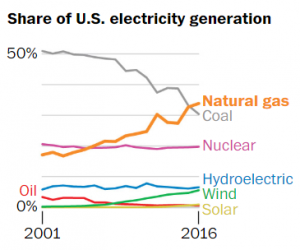
Source: The Washington Post
Solar generation also varies seasonally, and the sun does not shine at night, and both wind and solar generation vary with changing weather patterns, so these sources require either a more reliable backup source or a means of storing energy on the grid. Currently, utilities supplement variable wind and solar generation with natural gas, because varying the output of a gas generator is more efficient than varying the output of coal and nuclear sources; however, the Green New Deals also eliminate gas generation, leaving only grid storage and excess variable capacity as options.
Fully green power generation requires unprecedented energy storage at an astronomical cost
Several large scale, energy storage options exist, but all have severe limitations, and their total capacity is infinitesimal compared to the requirements of a fully green power grid. Pumped hydro is the most widely deployed. Essentially, electric motors use excess power from the grid to pump water uphill. When the energy is needed, the water flows downhill to the power a generator. Pumped hydro storage is practical in limited applications, but the very low energy density of flowing water makes it impractical on the scale required by a fully green power grid. According to Tom Murphy, professor of Physics at the University of California, San Diego, a fully green power grid requires pumped hydro storage on an incredible scale.
The existing 22-gigawatts worth of U.S. pumped-hydro facilities only gets us 1 percent of the way toward Murphy’s national battery. Achieving the other 99 percent through pumped-hydro alone would require hundreds if not thousands of projects on a scale never before seen, says Murphy.
One hypothetical option: build 170 large 12-gigawatt pumped-hydro systems, each one larger than the Grand Coulee dam. Another way to get there would be with more than 2,500 smaller, 600-megawatt systems. Even those would stand taller than the Hoover Dam and use 19 million cubic meters of concrete each.
The energy cost of the concrete alone would exceed three years of current U.S. energy consumption, Murphy estimates. And the amount of new surface water created by the projects would equal Lake Erie. Then there’s the question of where that water comes from, he notes.
Lithium-ion battery packs, now powering electric cars, are among the most practical grid storage options for rapid deployment, but their price is already prohibitive, and deploying them for grid storage demands limited resources already appreciating rapidly. The largest battery grid storage systems nearing deployment in California store a tiny fraction (.0009 percent) of the state’s energy requirement, but the output of wind and solar generation varies seasonally by fifty percent. According to researchers at MIT, a battery storage system enabling the United States to generate 80% of its electricity with solar and wind could cost $2.5 trillion, and this estimate permits some backup generation. The Green New Deal proposals, permitting practically no backup generation, require even more grid storage. Generating one hundred percent of electricity from solar, wind and hydro could increase the cost of power in California thirty-fold.
Building the level of renewable generation and storage necessary to reach the state’s goals would drive up costs exponentially, from $49 per megawatt-hour of generation at 50 percent to $1,612 at 100 percent.
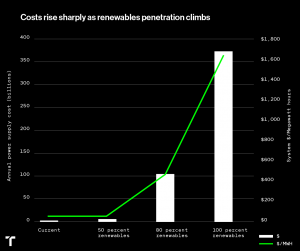

Green generation is more costly to build
Understanding the limitations of grid storage, proponents of a green energy transition propose simply to build more generating capacity. If variable sources generate half of their peak capacity at a seasonal trough, this solution builds generation with twice the necessary peak capacity. Green generation still varies with the weather, so this solution builds still more capacity and also expands the transmission grid to permit power transmission over vast distances to supplement more local generation when the wind does not blow or the sun does not shine locally. Generating and distributing sufficient power this way is possible in principle, but the cost is nonetheless prohibitive.
As green energy proponents readily concede, even without grid storage, the cost of building solar and wind generation far exceeds the cost of natural gas generation that utilities are now deploying but which the GPND and GND would force them to abandon.
The average cost in 2017 to install solar systems ranged from a little over $2,000 per kilowatt (kilowatts are a measure of power capacity) for large-scale systems to almost $3,700 for residential systems. A new natural gas plant might have costs around $1,000/kW. Wind comes in around $1,200 to $1,700/kw.
Longer term costs of wind and solar generation, ignoring the storage requirement, may be lower per unit of capacity, since the generators do not consume fossil or nuclear fuels, but over the transition decade, the cost of building green capacity is greater, and the volume of new capacity added over a decade is much greater than must be built otherwise, and the new capacity replaces recently built and undepreciated fossil fuel generation. Rate payers must continue to pay for abandoned power plants even while they pay to replace them, and without grid storage, they must replace each unit of abandoned capacity with twice as much variable capacity as well as an expanded transmission network.
The Green Party proposal cites a plan, proposed by Professor Mark Jacobson at Stanford University, to replace fossil fuel and nuclear generation with green generation with little grid storage, but Jacobson’s peers in the green energy movement widely criticized the plan. A team of scientists, led by Dr. Christopher Clack of Vibrant Green Energy, a green energy consulting group, published a critique of the Jacobson plan in the Proceedings of the National Academy of Sciences. Clack et al. conclude that the plan’s “numerous shortcomings and errors render it unreliable as a guide about the likely cost, technical reliability, or feasibility of a 100% wind, solar, and hydroelectric power system.”
Dr. Clack himself is hardly a green energy curmudgeon. He advocates a slightly less ambitious plan to move the United States to 80% green generation by 2030 with a mix of primarily variable, green generation plus some, existing nuclear and natural gas generation to back it up. The astronomical costs of a rapid transition to green energy occur when trying to push variable generation all the way to 100% of generating capacity. Even Dr. James Hansen, director of the Program on Climate Science, Awareness and Solutions at Columbia University’s Earth Institute and perhaps the world’s most alarming voice on climate change, disputes Jacobson’s assumptions.
Green energy is far more labor intensive
The Green Party proposal itself highlights the much greater cost of building green generation but promotes the cost as a jobs program.
It is estimated that every dollar spent on investments in renewable energy creates 3 times as many jobs as investments in nuclear power or fossil fuels. Also missing in the Jacobson study are manufacturing jobs for clean energy generation equipment and jobs for retrofitting the grid into a smart grid.
Regardless of the veracity of these figures, the greater costs imposed on consumers of electricity is indisputable and undisputed.
Electric cars and related technology are more costly
Neither the GPND nor the GND explicitly ban automobiles burning fossil fuels, but since transportation emits as much CO2 as electricity generation in the U.S., any serious effort to achieve net zero emissions of CO2 (an explicit goal of both proposals) must adopt zero emissions vehicles along with zero emissions electricity generation. The GND does “remove pollution and greenhouse gas emissions from the transportation sector as much as is technologically feasible, including through investment in (i) zero-emission vehicle infrastructure and manufacturing; (ii) clean, affordable, and accessible public transit; and (iii) high-speed rail”. The GPND also invests in mass transit and promises to “electrify everything else, including transport, heating, etc.”
Electric cars are increasingly popular and may ultimately be the future of personal transportation without a Green New Deal, even without the considerable subsidies they already enjoy, but accelerating their adoption with Federal mandates and requiring full adoption in a decade can only impose crippling costs on common consumers. The least costly Tesla still retails for nearly $45,000 before a Federal income tax credit expiring this year, but wealthy buyers line up for the vehicles. Tesla promises less costly models eventually, and established auto manufacturers are introducing less costly alternatives this year, but these vehicles still cost around ten thousand dollars more than conventional alternatives.
The widely heralded 2019 Hyundai Kona Electric, for example, retails for $36,450 while its conventional counterpart, the 2019 Hyundai Kona, retails for $19,990, a difference of $16,650. Including used car sales, this difference alone is roughly what Americans pay on average for an automobile, but the GPND requires every American to drive an electric car before 2030, and electric cars hardly exist on the used car market now.
Electric cars will continue to improve, and if they prove popular enough, prices will fall, but expecting prices to fall in only a few years ignores the facts. General Motors sells one of the most affordable fully electric vehicles, the Chevy Bolt, for $36,620, but even at this price, it sells the vehicle at a loss and doesn’t expect to sell electric vehicles profitably until sometime in the 2020s. This expectation doesn’t bode well for folks accustomed to paying less than $20,000 for a new or late model used car, folks the political “left” might be expected to champion.
More costly automobiles affect common Americans directly, but banning fossil fuels over a decade has more far reaching consequences. American industry generates energy from fossil fuels off of the grid, both because local generation is more efficient and because industrial demand could overwhelm the local grid. The GPND promises “a complete phase out of fossil fuels” by 2030, presumably including industrial generation, while the GND promises to remove “pollution and greenhouse gas emissions from manufacturing and industry as much as is technologically feasible”.
Kimberly-Clark, a leading U.S. manufacturer of paper products like Kleenex tissues and Huggies diapers, recently announced a $150 million dollar investment in natural gas generation to replace coal generation for its plant in Chester, Pennsylvania. If local wind or solar generation were less costly, the company would have chosen these options. Powering the plant with local wind or solar energy may not be economically viable or even physically possible, since the facilities have variable output and a much larger footprint, and powering the plant from the local grid may not be possible either. Forcing Kimberly-Clark to abandon fossil fuels over such a short period could force it to abandon the Chester plant, employing 800 Pennsylvanians, altogether, and any last resort jobs promised by the GPND may not compensate these employees for their loss. Imposing these losses from “the left” evokes more cognitive dissonance, and even the hint of a Green New Deal, forcing the company to abandon gas generation within a decade, imperils the transition from coal to much greener gas generation.
Subsidizing mass transit privileges urban populations and fails to anticipate technological progress
The GPND promises to invest in intra-city mass transit and inter-city railroads, and the GND is similar. Even if these investments benefit the 25% of Americans living in urban areas, permitting many of them to abandon individual means of transport altogether as the Green Party supposes, benefits for the 75% living in suburban and rural areas are not obvious. Mass transit systems are very costly, and because they require many years to realize, a system may be obsolete before it’s fully deployed. Proponents of automated driving and transportation as a service (TaaS) also imagine transformative technological change in the coming decade, change encouraging the adoption of electric vehicles, and this change could achieve Green Party objectives without the investments in mass transit.
Self-driving cars and small busses, carrying fewer passengers on highly variable routes, could offer passengers far greater flexibility at no greater, even lower, cost than conventional busses. TaaS could even offer most of the flexibility of owning a personal automobile at lower cost, and ride sharing also makes electric vehicles more attractive, since a need to refuel implies switching vehicles rather than waiting an hour to charge. How rapidly automated driving can emerge is certainly debatable, but it’s not more debatable than a realistic rate of adopting fully green energy generation. The top 11 automakers globally predict fully driverless cars by 2030, and most promise some level of automation much sooner.
A Federal program to automate transportation makes no more sense than a Federal Green New Deal, because the pace of technological progress, unguided by central planners, exceeds the rate at which political planners governing hundreds of millions can impose their plans. Planners do not know, cannot know and need not know the best solutions to energy generation, transportation and related problems even a decade in the future. Even if a carbon tax, to drive energy use generally away from fossil fuels, is defensible, severely limiting Americans’ transportation alternatives is not.
Without artificial fertilizers, food is much more costly
The GPND does not only phase out fossil fuels in the United States by 2030. It phases out other uses of petroleum and natural gas including the production of fertilizers and pesticides in favor of organic agriculture. A thorough discussion of modern agriculture is beyond the scope of this article, but roughly half of the world’s population eats food grown with hydro-carbon based fertilizers, and even if imposing organic agriculture across the United States would not starve Americans, the productivity of U.S. agriculture would certainly fall, and the cost of many foods would certainly rise. The rapid transition to local, organic sources would also severely disrupt existing food production and distribution systems with corresponding effects on employment in these sectors.
The Haber-Bosch process produces ammonia, and ultimately nitrogen based fertilizers, from atmospheric nitrogen and methane. Synthetic fertilizers and pesticides, as well as fossil fuels in agricultural and transportation machinery, have certainly raised the living standard of billions of the world’s poorest people. Suddenly abandoning these technologies globally could only reverse these gains in the short term, even starving millions, with the prospect of restoring gains highly uncertain. A Green New Deal in the U.S. alone does not imply these effects, but radical adoption of green energy in the U.S. alone also does not avoid a climate crisis, assuming that a crisis looms.
The choice is hard, but the price is worth it?
Proponents of a Green New Deal may believe that catastrophic consequences of climate change justify more costly energy, transportation and food and disruptions to established industry, but mainstream forecasts of this change does not warrant such drastic action. A detailed examination of these forecasts is also beyond the scope of this article, but a few claims of the Green Party warrant a reply. First, the GPND proposal claims that climate change is already responsible for tens of millions of refugees and kills hundreds of thousands of people annually, but it provides no source for these claims. Refugees from drought, flooding and extreme weather certainly exist, and attributing deaths to these causes, and to air pollution and the like, is reasonable enough, but distinguishing causes attributable to fossil fuels from similar causes is problematic, and these refugees and deaths exist almost entirely outside of the U.S. A Green New Deal confined to the U.S. would not ameliorate the problems. Furthermore, automobile accidents kill over a million people annually, but the Green Party does not propose to ban automobiles for this reason.
The proposal further claims that sea level is rising faster than predicted and could rise nine feet in the next fifty to 150 years. The source for this claim is an article by James Hansen, whose assessments are routinely more alarming than the consensus, and the article itself concedes that its conclusions “differ fundamentally from existing climate change assessments”. Actual measures of sea level rise do not indicate such a rapid rise and indicate little change in the rate of increase over decades, a rate of barely one foot per century.

Libertarians may nonetheless applaud a proposal to cut U.S. military spending in half. If a proposal only shifted so much Federal spending from the warfare state to green energy subsidies and related employment, without banning alternatives for cost-conscious Americans and established industry and without undermining the green revolution, the shift would almost certainly be change for the better, even if our own purists would prefer neither the military spending nor any Green New Deal.


